This is the first Hailanghao bing I have seen "in the flesh", and didn't realise that they were a brand of the Mingxiangyayuan Factory [Famous Fragrant Elegant Garden]. Thanks to Nada for so kindly finding this one.
The wrapper tells us (across the centre, in brown characters) that this is gaoshan [high mountain], qiaomu [arbor], dabaicha [big white tea]. I have little experience with real yinhao [silver-fur] shengpu, save for the 2005 Yinzhen that my dear wife brought back from her trip to Maliandao last year. A priori, it's usually safe to assume that they are pleasant to drink now, but lack the complexity for future joys - and they're typically quite pricey.
Yangtashan is the mountain in Jinggu from which Dabaicha originates - a typically large-leaf affair, also used in hongcha.
This cake does not look like normal yinhao, and that's a very good thing: we have lots of proper leaves mixed in with the (really huge) silver-furred tips. The "da" is "dabaicha" is really well-deserved here. The compression is loose, and the quality of the leaves homogenous throughout.
The soup is crystal clear, and coloured a light yellow (as shown below). Unwittingly, I have seriously underbrewed this tea, forgetting that these types of pu'er are usually quite understated. The massive size of the leaves results in almost no sediment. Only habit keeps me using the hulu [gourd filter].
Tasty and sweet, it has the ubiquitous creaminess typical of yinhao tea, with some interest underneath provided by the "real" leaves.
Brewing this robustly just brings out a feeling of overbrewed lucha; this is a straightforward tea to be taken at face value. That value is pretty and sweet, and fresh for a morning waking-up session.
Thanks again to Nada for a treat into territory that I wouldn't otherwise explore.
The wrapper tells us (across the centre, in brown characters) that this is gaoshan [high mountain], qiaomu [arbor], dabaicha [big white tea]. I have little experience with real yinhao [silver-fur] shengpu, save for the 2005 Yinzhen that my dear wife brought back from her trip to Maliandao last year. A priori, it's usually safe to assume that they are pleasant to drink now, but lack the complexity for future joys - and they're typically quite pricey.
Yangtashan is the mountain in Jinggu from which Dabaicha originates - a typically large-leaf affair, also used in hongcha.
This cake does not look like normal yinhao, and that's a very good thing: we have lots of proper leaves mixed in with the (really huge) silver-furred tips. The "da" is "dabaicha" is really well-deserved here. The compression is loose, and the quality of the leaves homogenous throughout.
The soup is crystal clear, and coloured a light yellow (as shown below). Unwittingly, I have seriously underbrewed this tea, forgetting that these types of pu'er are usually quite understated. The massive size of the leaves results in almost no sediment. Only habit keeps me using the hulu [gourd filter].
Tasty and sweet, it has the ubiquitous creaminess typical of yinhao tea, with some interest underneath provided by the "real" leaves.
Brewing this robustly just brings out a feeling of overbrewed lucha; this is a straightforward tea to be taken at face value. That value is pretty and sweet, and fresh for a morning waking-up session.
Thanks again to Nada for a treat into territory that I wouldn't otherwise explore.

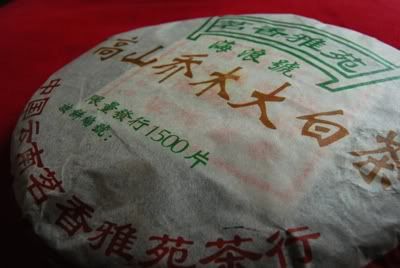
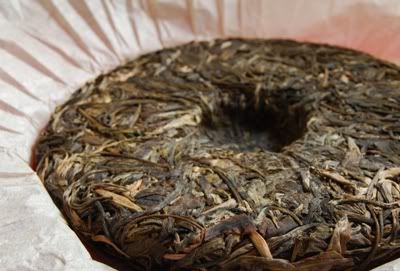
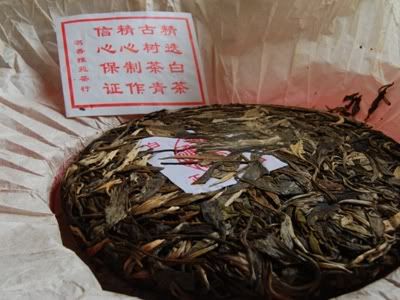
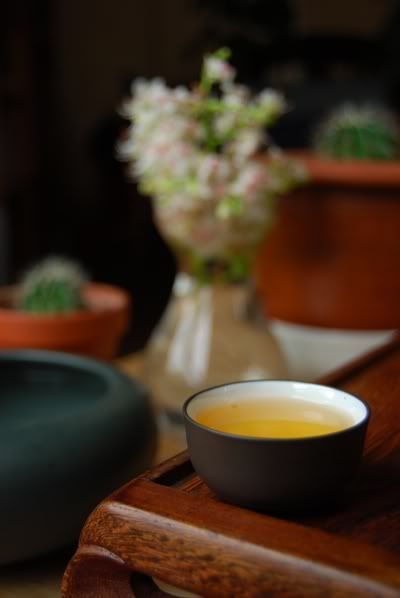
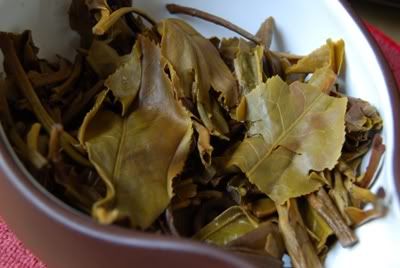
Mingxiangyayuan and Hai Lang Hao are synonymous. It says "Cha Hang 茶行" not "Cha Chang 茶厂" on the wrapper.
ReplyDeleteAs of 2006, Hai Lang Hao (MXYY) productions are pressed in the Tian Pin factory in Kunming, as it is a QS certified facility. Hai Lang's productions are solely his, despite the 2006 and beyond wrappers mentioning the Tian Pin Tea Factory.
Oh, BTW nice review. Nice to see this cake again. It really is beautiful!
ReplyDeleteI’d be temped to put this long(ish) term storage. Looks like it might have potential. john
ReplyDeleteThose leaves are huge! Absolute monsters! I love how they're just kind of laid out on the face of the bing.
ReplyDeleteDear Scott,
ReplyDeleteThanks for the notes, it's good to know the details. I remember that Nada was particularly impressed by Hai Lang's outfit.
It is a pretty tea, but you get the impression it has been "dressed". :)
Dear John,
It might do, yes indeed. It's a charming and light affair, though, and I see myself getting through much of it this summer if it's warm!
Dear Jamus,
They are whopping, and they fall away from the tighter inner-bing so easily that you really feel as if they are there for display. :)
Toodlepip all,
Hobbes
What an interesting tea! The leaves do look bold and rustic. On thing that leaves me somewhat perplexed is that I was always under the impression that yinhao pu-erh were white pu-erhs comprised of buds. Very interesting. :)
ReplyDeleteDear Bill,
ReplyDeleteVery good point - when I first looked at this tea, I thought it was going to be yinhao from its name. As rightly you say, those are silver tips. I've since learned that dabaicha is a big-leaf in itself, sometimes used for pu'er, but also used for hongcha or even lucha. So, in my notes, I was making comparison with yinhao.
Interestingly, it does have a lot of the character of yinhao, but with a touch more complexity. I usually find yinhao frightfully one-dimensional, and they don't seem to change with age. This tea was very enjoyable, though, as was another similar bing on which notes are due to follow.
That said, this tea doesn't really develop during a single session, but has plenty of character that keeps the attention nonetheless.
Toodlepip,
Hobbes
Dabaihao always looks very good. Personally I'd go with the safer choice of a Yiwu or some other thing -- I find the taste of dabaihao too close to silver tips and am not sure it will be good in the long run.
ReplyDeleteHailang, btw, is what the guy calls himself on places like Sanzui (I'm sure he has a real name, although I don't know what). Mingxiangyayuan is, I believe, the name of his store. He's from Shanghai originally, and they still have a store in Shanghai's tea market.
Dear MarshalN,
ReplyDeleteI'm with you, I don't usually gamble on yinhao and, fine though this cake is, probably won't chase dabaicha with too much dedication.
The flavours of yinhao and dabaicha are very similar, particularly in that creamy note I mentioned in the article, but at least dabaicha has some complexity and content. It can make a lovely morning cup, I have been able to conclude!
Thanks for the details on "Hailang" and his stores - I was originally going to write "Mr. Hai" or "Mr. Lang" but then thought that it didn't really fit the template for Chinese names. :)
Toodlepip,
Hobbes
Actually 李海 Li Hai is from Kunming, his father is from Shanghai, but his mother and father live there. He has a shop in Shanghai and Kunming. He is (i think) 29 or 30 years old.
ReplyDeleteHe is a licensed Da Yi (Menghai) distributor for Shanghai. He is a huge proponent of Kunming style dry storage and will typically "poo poo" wetter stored stuff from HK, GZ and Taiwan.
I spend alot of time at their shop here in Kunming so I know all the details.
- Scott
Thanks, Scott - nice to know the details, and also his name: "Mr. Li" it is...
ReplyDeleteToodlepip,
Hobbes